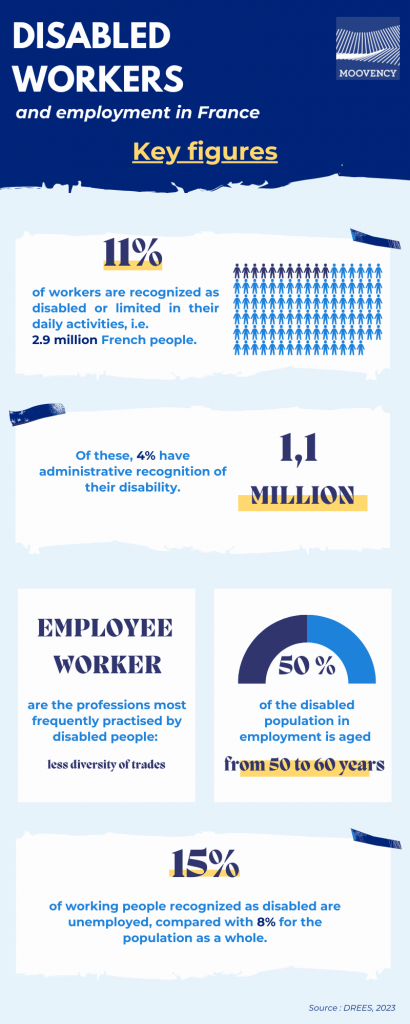Disabled workers and employment in France
In 2021, 11% of workers were recognized as disabled or limited in their daily activities, totaling 2.9 million people in France (DREES 2023).
Disabled workers are legally defined by Article L. 5213-1 of the French Labor Code : “A disabled worker is defined as any person whose opportunities to obtain or retain employment are effectively reduced as a result of impairment of one or more physical, sensory, mental, or psychological functions.”
There are inequalities in the professional integration of people with disabilities in France, and it is crucial to find solutions to facilitate these disabled workers in returning to or maintaining their employment.
Discover in our article key figures on disabled workers, various programs for professional integration and job retention, organizations, as well as our advice related to MSDs to prevent certain situations of disability.
Disabled Workers and Employment in France : Key Figures

How to promote the integration of disabled workers?
RQTH: What to know about professional integration
What is a RQTH?
The Recognition of the Quality of Disabled Worker (RQTH) is an administrative decision allowing access to a set of measures for job retention and/or access to a new job.
The RQTH concerns “any person whose opportunities to obtain or retain employment are reduced due to the impairment of one or more physical, sensory, mental, or psychological functions.” This recognition is generally granted for a specified period and must be renewed, but in some cases, it can be granted for life if the disability does not evolve favorably.
For disabled workers in employment, it allows them to benefit from a set of measures such as:
- Workstation adaptation;
- Flexible working hours;
- Obligation to employ disabled workers (OETH) in the private and public sectors.
What is the obligation to employ disabled workers (OETH) ?
According to the 1987 law, any company with at least 20 employees is required to employ disabled workers in a proportion of 6% of its total workforce. If this rate is lower for certain companies, they must pay a financial contribution.
Now, following the 2020 reform, all employers, including those with fewer than 20 employees, must declare the disabled workers they employ. This will help to better identify their needs and respond to them more effectively. However, only employers with 20 or more employees will be subject to the obligation to employ 6% of disabled workers.
Today, therefore, many companies are subject to this obligation to employ, and as of 2022, there were more than 111,300.
This obligation to employ encourages companies to hire disabled workers and promote their professional integration.
For job seekers, the RQTH provides disabled workers with access to various schemes:
– Priority access to training funded by the Personal Training Account (CPF), by Agefiph (the Association for the Management of the Fund for the Insertion of Disabled Persons), or FIPHFP (the Fund for the Insertion of Disabled Persons in the Civil Service) or referral to adapted programs.
– Access to a skills assessment adapted to the situation of the disabled worker and to qualifying training ;
– Access to specific employment integration programs, such as :
- Supported employment programs ;
- Rehabilitation internships ;
- Specific contractual recruitment ;
- Adaptation of competitions, as in the civil service ;
- Subsidized contracts under the Employment Paths for Skills program (PEC) ;
- Support from specialized networks such as “Cap emploi” and Agefiph ;
- Assistance with creating or taking over a business.
How to support the retention of disabled workers in employment ?
To maintain the employment of a disabled worker, solutions exist to preserve their job and continue working under adapted conditions. Job retention is a major issue for both the employee and the organization, and it is essential to be informed about the different perspectives to implement.
As an employee, it is not always easy to discuss these matters with colleagues; the occupational physician can be a privileged interlocutor to address difficulties. After analyzing the health status and the job, several scenarios can be considered:
– Technical adaptation of your workstation or work tools, purchasing specific equipment;
– Organizational adjustments : organizing your tasks or working hours;
– Professional redeployment, compatible with the recommendations of the occupational physician: finding an equivalent position but more suitable for the worker’s health condition.
It should be noted that the employer is required to consider the recommendations of the occupational physician to enable you to work in good conditions.
What other schemes are available for job retention ?
- CAP EMPLOI: Specialized placement agencies responsible for preparing, supporting, providing sustainable follow-up, and maintaining the employment of disabled individuals.
- SAMETH : The Support Service for Maintaining Employment of Disabled Workers facilitates job retention by finding solutions to avoid dismissal due to incapacity.
- ESPO & ESRP : Pre-orientation/Professional Rehabilitation Establishments and Services offer disabled workers evaluation, training, and orientation actions.
MSD & Disabled Workers
Are MSDs the Illness of the Century?
87% of recognized occupational diseases are MSDs, and 45% of MSDs can lead to severe consequences (permanent disabilities).
The consequences of MSDs on employees are numerous. On the one hand, it is essential for a company to understand their challenges and implement a prevention approach with its employees. On the other hand, it is crucial to address these disorders when they are already present and preserve the health and position of an employee.
At Moovency, our KIMEA tools are designed to help companies identify the most suitable workstations for employees with medical restrictions or conditions.
By focusing on the analysis of biomechanical constraints, KIMEA allows for the identification of the most stressed joints in the various tasks of a workstation, highlighting whether the constraints are minimal or not compared to the employee’s disability.
KIMEA thus enables the measurement of a workstation’s compatibility with an employee’s medical restrictions, finding the right alternative to provide them with working conditions adapted to their condition.
Because no one should have to choose between their health and their job…
Sources :
- Mon Parcours Handicap Gouv – Travailleur handicapé : https://www.monparcourshandicap.gouv.fr/glossaire/th
- Mon Parcours Handicap Gouv – Maintien dans l’emploi https://www.monparcourshandicap.gouv.fr/emploi/quest-ce-que-le-maintien-dans-lemploi
- Mon parcours Handicap Gouv – Reconnaissance de la qualité de travailleur handicapé https://www.monparcourshandicap.gouv.fr/aides/la-reconnaissance-de-la-qualite-de-travailleur-handicape-rqth
- DREES – Le handicap en chiffres, édition 2023 https://drees.solidarites-sante.gouv.fr/sites/default/files/2023-04/Handicap2023.pdf
- EU OSHA – Handicap et santé et sécurité au travail https://osha.europa.eu/fr/themes/disability-and-work
- AGEFIPH – Emploi et chômage des personnes handicapées, 1er Semestre 2023 https://www.agefiph.fr/sites/default/files/medias/fichiers/2023-11/Agefiph-TB_Semestre1_2023-11.pdf
